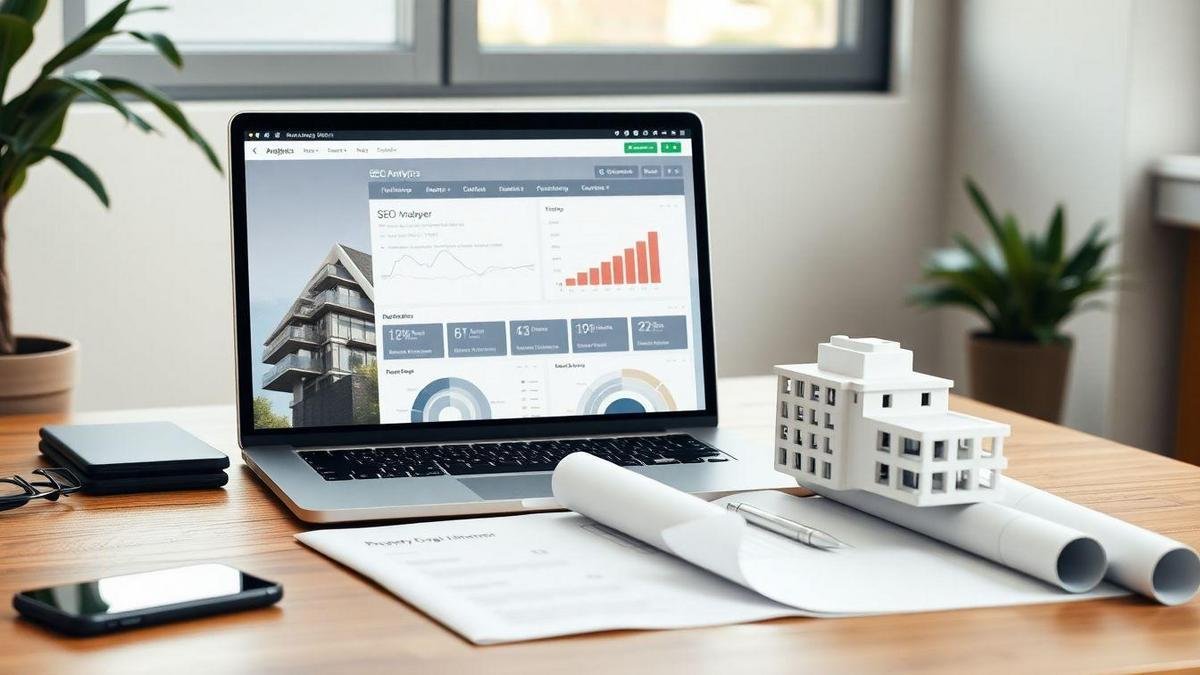Real estate SEO for property developers
Real estate SEO for property developers is a practical playbook to drive leads and sell homes. It gives a clear plan for strategy, KPIs, and how SEO fits the sales funnel. Topics include keyword research, long‑tail and local terms, on‑page tactics (titles, meta descriptions, image alt), technical SEO (site speed, mobile, sitemaps, robots), local SEO (Google Business Profile, neighborhood pages), content ideas (blogs, guides, video tours, FAQs), link building, schema for listings, and quick checklists and metrics to follow. For a broader view on multi‑channel tactics that complement SEO, see the real estate digital marketing strategies playbook.
- Target local keywords and neighborhood phrases.
- Optimize property pages with clear titles and meta descriptions.
- Add high‑quality images with descriptive alt text (consider aerials from professional drone real estate photography).
- Publish regular, informative blog posts about market trends.
- Build backlinks from trusted local and industry sites.

How developers build a property developer SEO strategy using Real estate SEO for property developers
Key business goals and KPIs to track
They set clear business goals before SEO work begins. Goals guide keywords, content, and tracking.
| Business Goal | Key KPIs | Why it matters |
|---|---|---|
| Increase qualified leads | Organic leads; lead quality score | Leads drive sales and pre‑sales |
| Grow organic traffic | Organic sessions; pages per session | Feeds top of funnel |
| Improve local visibility | Local pack impressions; GBP actions | Local searches convert to visits |
| Shorten sales cycle | Time from first visit to inquiry | Faster decisions lower cost |
| Boost conversion rate | Conversion rate; cost per lead | Higher conversion lowers spend per sale |
Track weekly and report monthly using Google Analytics, Search Console, and CRM data — for example a dedicated CRM for land and development teams — to connect SEO to revenue.
How Real estate SEO for property developers fits the sales funnel
Map SEO tasks to each funnel stage to drive interest (top), nurture (middle), and close (bottom).
| Funnel Stage | SEO Tactics | Content / Example | KPI to watch |
|---|---|---|---|
| Awareness (Top) | Keyword research; long‑form blogs; local landing pages | Neighborhood guide; “Why buy in X” | Organic clicks, impressions |
| Consideration (Middle) | On‑page optimization; FAQs; virtual tours | Comparison pages; brochures; galleries | Time on page, downloads |
| Decision (Bottom) | Local SEO; schema; reviews; CTAs | Project pages; booking forms | Form submissions, calls |
Pair SEO with social amplification to grow awareness — see tactics for social media marketing for real estate developers — and use retargeting to re‑engage interested visitors (real estate retargeting with AI). Focus on local intent keywords: project names, neighborhood names, and phrases like “move‑in ready” or “off‑plan units.” Optimize meta tags and schema so results stand out and bring qualified traffic to project pages.
Quick checklist for an SEO plan for developers
- Define business goals and KPIs.
- Research keywords: project names, neighborhood property terms, buyer intent.
- Create content for each funnel stage: guides, FAQs, project pages.
- Optimize on‑page: title tags, meta descriptions, headers, images.
- Implement local SEO: Google Business Profile, local citations, landing pages.
- Add schema: property, offer, review markup.
- Build links via local partners, press, and networks.
- Track and report: organic traffic, leads, conversions, local metrics.
- Test CTAs and simplify forms to reduce friction.
- Review monthly and reallocate efforts based on top KPIs.
For hands‑on tools to capture and nurture leads, pair SEO with a toolkit described in real estate lead generation tools.
Keyword research and the role of Real estate SEO for property developers
Keyword research is a cornerstone. Treat keywords like a compass: the right terms point to buyers, renters, and investors. For developers, the phrase Real estate SEO for property developers should guide content, landing pages, and paid campaigns. Short phrases show demand; long phrases show intent; local words show proximity and higher conversion.

Tools for keyword research
- Google Keyword Planner — baseline volume and ad planning.
- Google Trends — seasonality and rising interest.
- Ahrefs / SEMrush / Moz — volumes, difficulty, competitive pages.
- AnswerThePublic — question‑style phrases.
- Ubersuggest — low‑cost idea generation.
Cross‑check results: a keyword with decent volume and lower competition becomes a priority. Update keyword tracking weekly or monthly.
Choosing long‑tail and local keywords
Long‑tail keywords bring qualified traffic and convert better. Combine product location intent.
- Product: new home, off‑plan, penthouse, townhouse
- Location: neighborhood, city, landmark
- Intent: for sale, price, floor plans, move‑in date
Examples:
- “new 3‑bedroom apartments near Downtown“
- “off‑plan townhouses Brookside with parking”
- “move‑in ready flats northside under $300k”
Make a page per neighborhood development to improve relevance and local rankings.
Top keyword list template (keep in a shared sheet)
| Keyword | Search Intent | Volume (monthly) | Competition | SERP Features | Landing Page | Notes |
|---|---|---|---|---|---|---|
| e.g. “new homes in [City]” | Transactional | (value) | low/med/high | maps, snippet | /projects/new-homes-city | Target neighborhood names, add floor plans |
Assign one owner per keyword to avoid overlap.
On‑page SEO for property listings and landing pages
On‑page SEO helps listings and landing pages rank and convert. Treat each page like a shop window: show clear benefits, location, and a bold CTA. Use the phrase Real estate SEO for property developers naturally in page copy and headings where relevant.

Page elements checklist
| Element | What to do | Why it matters |
|---|---|---|
| Title tag | Property type location key benefit (50–60 chars) | Drives clicks |
| URL | Short, hyphens, include location | Easy to read/share |
| H1 | Match title intent | Sets expectation |
| Meta description | 120–160 chars, include CTA & price cue | Boosts CTR |
| Images | Optimized filenames & alt text | Search accessibility |
| Content | Short paragraphs, bullet features, local info | Keeps visitors engaged |
| Schema | Add property schema markup | Improves rich results |
Test titles and descriptions like a shopkeeper testing window displays—small changes can lift clicks fast.
Meta titles & descriptions that boost clicks
Pattern for titles: [Bedrooms] [Property type] [Location] — [Main benefit] (50–60 chars).
Meta descriptions: start with the top benefit, add specifics, end with a CTA (120–160 chars).
Example:
- Title: 2‑Bed Apartment Downtown — Sea View & Parking
- Description: Spacious 2‑bed with sea view. Concierge and parking. Book a viewing today.
Tips:
- Put important words first.
- Use action verbs: Book, View, Call.
- Avoid keyword stuffing—write for people first.
Image filenames and alt text
Use descriptive, hyphenated filenames and short alt text.
| File name example | Alt text example |
|---|---|
| grand-avenue-2br-balcony.jpg | 2‑bed apartment on Grand Avenue with balcony and sea view |
| sunrise-pool-developername.jpg | Outdoor pool at Sunrise Residences by DeveloperName |
| kitchen-open-plan-2br.jpg | Open‑plan kitchen in 2‑bed unit, stainless appliances |
Rules:
- Use hyphens and lowercase.
- Mention location and type when relevant.
- Keep alt text to one simple sentence.
- Avoid repeating identical keywords across all images.
Consider complementing interior shots with aerials to show context — see examples of quality drone photography for real estate.
Technical SEO for property developer websites

Why site speed and mobile matter
Search engines favor pages that load fast and work well on phones. For property sites, slow pages lose visitors and hurt rankings. Focus on Core Web Vitals and mobile‑first UX: compress images, defer scripts, use a CDN, and keep forms short. For a mobile‑first approach to real‑estate experiences, see mobile‑first real estate marketing best practices.
XML sitemaps and robots rules
A clean sitemap and correct robots.txt guide crawlers to canonical pages.
| File | Purpose | Best practice |
|---|---|---|
| sitemap.xml | Lists important pages | Include only canonical pages; split large sitemaps; gzip |
| robots.txt | Tells crawlers what to fetch | Block admin/staging; add sitemap location; allow CSS/JS |
| sitemap index | Points to multiple sitemaps | Use when >50k URLs |
Submit sitemaps to Search Console and monitor index coverage. Use canonical tags to handle parameters and duplicates.
Technical audit essentials
| Priority | Check | Tool / Action |
|---|---|---|
| High | Crawl errors & 5xx | Search Console; fix server issues |
| High | Indexation status | Coverage report; update sitemap |
| High | Mobile rendering | Mobile‑Friendly Test; fix layout shifts |
| Medium | Page speed & CWV | Lighthouse / PageSpeed Insights; optimize assets |
| Medium | Canonical & duplicates | Check canonical tags; clean sitemap |
| Low | Structured data | Rich Results Test; fix errors |
Run audits before launches and after template changes. Small fixes (remove unused scripts, compress images) often yield quick gains. For developer tooling and hosting recommendations, consult the list of tools for developers.
Local SEO for property developers

Local search helps developers meet buyers close to the project. With the right steps, Real estate SEO for property developers brings traffic, calls, and visits from nearby prospects.
Google Business Profile (GBP) and local citations
A strong GBP is like a front desk—hours, photos, and contact info. Consistent local citations (NAP) across directories and local outlets build credibility. Reviews and prompt replies matter.
| Item | Why it matters | Quick tip |
|---|---|---|
| Business name | Matches search results | Use the same name everywhere |
| Address | Shows on Maps | Use a sales office if on‑site address is private |
| Phone | Drives calls | Use a trackable local number |
| Hours | Sets expectations | Update for showings/events |
| Photos | Builds desire | Add staging and street shots |
| Reviews | Build trust | Reply to reviews with helpful notes |
| Categories | Help ranking | Pick closest matching categories |
Example: Claim GBP, add weekly photos, reply to reviews—calls often rise in weeks.
Neighborhood pages and local keywords
Neighborhood pages act like signposts. Use local keywords: neighborhood names, landmarks, transit stops, schools. Keep content short, factual, and useful: walking time to transit, nearby shops, recent improvements. Add a map, photos, and a local testimonial.
| Keyword type | Example | What buyer wants |
|---|---|---|
| Neighborhood product | “Riverside condos for sale” | Listings and pricing |
| Amenity proximity | “near subway station” | Commute info |
| Comparison | “new builds vs resale in Midtown” | Decision help |
| Transactional | “book a viewing Riverside” | Call to act |
Local listing checklist
- Claim and verify Google Business Profile (High).
- Ensure NAP consistency across sites (High).
- List on local directories and portals (Medium).
- Ask satisfied visitors to leave reviews and reply promptly (High).
- Create one page per neighborhood with keywords (High).
- Add local and product schema (Medium).
- Test pages on mobile for speed/layout (High).
- Upload staged, street, and amenity images (Medium).
- Use tracking numbers and UTM tags for campaigns (Medium).
- Embed a clear map and sales‑office pin (High).
Short tasks: claim GBP add photos; create [Neighborhood] new homes page; ask one buyer per week for a review.
Content marketing to educate and convert

Focus on buyer pain points and direct answers. Keep topics practical and search‑friendly. Weave Real estate SEO for property developers into meta descriptions and headings where relevant.
Blog & guide topic ideas
- Local market guides — neighborhood pros/cons, transit, schools.
- Buying process step‑by‑step — plain steps from offer to closing.
- Financing and costs — loan types, down payment examples.
- Design and finishes — choices that affect resale.
- Maintenance and warranties — what’s covered and how to claim.
- Investment cases — rental yield basics.
- Comparisons — apartment vs townhouse vs single‑family.
- Checklists — viewing, closing, moving (lead magnets).
| Topic | Primary Goal | Best Format | SEO Hook |
|---|---|---|---|
| Local market guides | Educate | Short guide map | Local intent keywords |
| Buying process | Reduce friction | Numbered blog post | Long‑tail buyer queries |
| Financing | Build trust | FAQ calculator | Mortgage terms |
| Design | Inspire | Photo gallery tips | “best finishes for resale” |
| Checklists | Convert leads | Downloadable PDF | Lead magnet phrase |
Why video tours and FAQs help
Video tours show properties in motion and boost engagement. FAQs target voice search and featured snippets—short Q&A blocks match how people ask questions. Combine a 1‑minute video with five concise FAQs on the same page to lift engagement and rank for buyer queries. Use cinematic shots and aerial segments from drone photography, and feed video viewers into a retargeting sequence outlined in real estate retargeting with AI.
Content calendar template
Post one core piece per week and reuse snippets for social (see social media marketing tactics).
| Week | Content Type | Topic Example | SEO Focus | CTA |
|---|---|---|---|---|
| Week 1 | Neighborhood guide | Transit and schools | Long‑tail local keywords | Download map |
| Week 2 | Listing spotlight (video) | 2‑bed showflat tour | Property video schema | Book viewing |
| Week 3 | FAQ article | Financing questions | Question phrases | Contact broker |
| Week 4 | Checklist / Lead magnet | Moving checklist | Lead magnet keyword | Email signup |
Tip: track which topics generate leads and repeat the format.
Link building for real estate developers

Local partners and suppliers
Partners (suppliers, architects, local businesses) provide contextual links that drive referral traffic and local relevance.
| Partner type | Typical placement | Value |
|---|---|---|
| Supplier | Project gallery or case study | Contextual, buyer intent |
| Architect / designer | Portfolio or blog feature | Authority, industry relevance |
| Local businesses | Community pages, sponsorship lists | Local signals, referral traffic |
| Subcontractor | Testimonials or project pages | Proof of work |
A supplier link to a project page is more valuable than a generic homepage link. These links support Real estate SEO for property developers by tying the site into local industry networks.
Press coverage and industry mentions
Editorial links from local news and trade publications add credibility and reach. Good press drives referral visits and can lift rankings for project queries. Consider how PR and positioning feed into a broader real estate branding strategy to build long‑term trust.
Good press link traits:
- Placed inside editorial copy.
- On relevant/local outlets.
- Clearly mentions developer and project.
Safe outreach checklist
- Target relevant partners (suppliers, architects).
- Offer value: photos, specs, guest post ideas.
- Request contextual links within related content.
- Aim for editorial mentions over directories.
- Avoid low‑quality/spammy sites.
- Keep anchor text natural: brand or project names.
- Track referrals and clicks from partner links.
- Mark paid links rel=”sponsored” when required.
- Build and maintain relationships.
- Record permissions and publication dates.
Schema markup for property listings

Structured data types to add
For Real estate SEO for property developers, use schema that matches the listing:
- Offer — price and availability
- House / Apartment / SingleFamilyResidence — property type
- PostalAddress — address fields
- GeoCoordinates — lat/long
- ImageObject / VideoObject — media
- AggregateRating — if reviews present
- PriceSpecification — detailed pricing
| Schema Type | Purpose | Key properties |
|---|---|---|
| Offer | Marks listing details | price, priceCurrency, availability, url |
| House / Apartment | Describes property kind | name, description, numberOfRooms, floorSize |
| PostalAddress | Precise address | streetAddress, addressLocality, postalCode |
| GeoCoordinates | Map pin | latitude, longitude |
| ImageObject | Photos for rich cards | contentUrl, caption, width, height |
| AggregateRating | Ratings in results | ratingValue, reviewCount |
If a page lists multiple units, use an ItemList or multiple Offer entries.
Testing schema
- Run URL in Google Rich Results Test.
- Fix errors first, then warnings.
- Use Schema Markup Validator for schema.org checks.
- Validate JSON‑LD syntax with a linter.
- Inspect URL in Search Console and monitor Enhancements reports.
Examples (replace placeholder values):
Single property (Offer House PostalAddress) — JSON‑LD snippet (paste into page head):
{
“@context”: “https://schema.org”,
“@type”: “Offer”,
“price”: “450000”,
“priceCurrency”: “USD”,
“availability”: “https://schema.org/InStock”,
“url”: “https://www.example.com/listings/123”,
“itemOffered”: {
“@type”: “House”,
“name”: “3‑Bed Family Home”,
“description”: “3 bed, 2 bath near downtown.”,
“numberOfRooms”: 3,
“floorSize”: {
“@type”: “QuantitativeValue”,
“value”: 1400,
“unitCode”: “FTK”
},
“address”: {
“@type”: “PostalAddress”,
“streetAddress”: “123 Main St”,
“addressLocality”: “Anytown”,
“postalCode”: “12345”,
“addressRegion”: “CA”,
“addressCountry”: “US”
},
“geo”: {
“@type”: “GeoCoordinates”,
“latitude”: 37.422,
“longitude”: -122.084
},
“image”: “https://www.example.com/photos/123.jpg”
}
}
Listing with rating and images — JSON‑LD snippet:
{
“@context”: “https://schema.org”,
“@type”: “Offer”,
“price”: “350000”,
“priceCurrency”: “USD”,
“itemOffered”: {
“@type”: “Apartment”,
“name”: “Downtown Studio”,
“image”: [
“https://www.example.com/photos/201a.jpg”,
“https://www.example.com/photos/201b.jpg”
],
“aggregateRating”: {
“@type”: “AggregateRating”,
“ratingValue”: “4.6”,
“reviewCount”: 24
}
},
“url”: “https://www.example.com/listings/201”
}
Good schema, validated and error‑free, increases the chance of rich cards appearing in search.
SEO for new housing developments — from launch to sale

Plan each launch step with search visibility in mind. From first sketch to final sale, Real estate SEO for property developers guides where to place content, links, and listings. Good SEO drives traffic, builds trust, and fills the sales funnel early.
Pre‑launch pages and pre‑registration
Pre‑launch pages act like a beacon—they attract buyers and search engines before the showflat opens.
- Publish a focused pre‑launch page with project name, location, and benefits.
- Add a pre‑registration form to capture contacts and intent.
- Use local keywords and schema to attract organic visitors.
Example: a 120‑unit pre‑launch page captured 400 pre‑registrations in six weeks and converted into prioritized viewings. Combine the pre‑launch capture with email and retargeting workflows from real estate retargeting campaigns and lead tools referenced in lead generation tools for real estate.
Metrics to measure SEO impact on sales
Track metrics that link SEO to revenue.
| Metric | What it reveals | Typical tool |
|---|---|---|
| Organic sessions | Search‑driven visits | Google Analytics |
| Organic leads | Leads from search | CRM GA goals |
| Conversion rate (organic) | Visitors → leads | GA / CRM |
| Local impression share | Visibility for key terms | Search Console |
| Keyword rankings | Position for target phrases | Rank tracker |
| Pages per session | Engagement depth | GA |
| Time on page | Content relevance | GA |
| Assisted conversions | SEO’s role in multi‑touch sales | GA MCF |
For higher‑level measurement and attribution, integrate SEO data with predictive modelling and forecasting described in predictive analytics for real estate marketing to tie traffic into expected sales outcomes.
Benchmarks: conversion rate from organic typically 1%–5%; optimized pre‑launch pages 3%–10%. Match SEO data with CRM to see which keywords and pages lead to deposits and contracts.
Pre‑launch SEO checklist
| Task | Why it matters | Priority |
|---|---|---|
| Create a focused pre‑launch page | Captures visibility & early interest | High |
| Add pre‑registration form & privacy note | Converts visitors into contacts | High |
| Use local keywords (city, neighborhood, landmarks) | Targets local buyers | High |
| Add schema (address, project type, availability) | Helps rich results | Medium |
| Optimize title & meta description | Improves CTR | High |
| Mobile‑first design & fast load times | Reduces bounce | High |
| Create content plan for launch updates | Keeps momentum | Medium |
| Tag leads in CRM with source data | Tracks SEO → sales | High |
If project feasibility is still in progress, align SEO timing with your development roadmap and feasibility work outlined in feasibility reporting.
Prioritizing Real estate SEO for property developers (practical next steps)
- Start with a 30‑day sprint: set goals, claim GBP, publish a pre‑launch or neighborhood page, and run a basic technical audit.
- Week 1–2: fix critical site speed and mobile issues, optimize top 5 property pages (titles, metas, schema, images).
- Week 3–4: create one local guide one FAQ and publish; outreach to 3 local partners for contextual links.
- Month 2: scale content calendar, monitor KPIs, iterate based on leads and conversion data.
Pair these sprints with channel work from the broader digital marketing strategies playbook to ensure SEO feeds social, email, and paid campaigns.
This approach treats Real estate SEO for property developers as a measurable business function. Small, repeatable actions win.
In the End…
Treat SEO as a practical, measurable tool—not a magic trick. Focus on strategy and KPIs, track organic sessions, leads, and conversion rates, and prefer short tests over endless planning.
Keywords are a compass—use long‑tail and local phrases to guide buyers to the right pages. Build pages like shop windows: clean on‑page signals, sharp meta titles and alt text, and a single clear CTA above the fold. Tune the site like a race car: optimize site speed, mobile UX, sitemaps, and robots rules. Run regular technical audits.
Use local SEO—Google Business Profile, neighborhood pages, consistent NAP, and reviews—to show up where buyers look. Produce content (guides, video tours, FAQs) to educate, and pair it with schema so listings stand out in search. Earn links and press from honest partnerships; quality beats volume.
Small, repeatable actions win. Use the checklists, run the calendar, and measure against revenue. When SEO is treated as a business function, it fills the funnel and shortens the sales cycle.
For more practical playbooks and checklists, visit: https://realhubly.com
Eduardo Bugallo, PhD.

2 Responses
[…] real estate SEO tactics for property developers and focused keywords to get […]
[…] Marketing For Real Estate Investors: Proven Strategies To Win In 2025 on Real Estate SEO for Property Developers: Insider Tips to Rank #1 in 2025September 10, […]